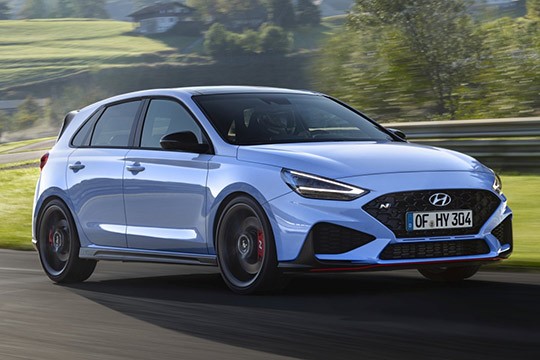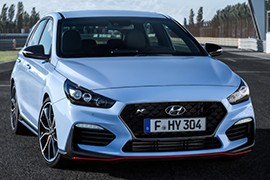HYUNDAI i30 N Models/Series Timeline, Specifications & Photos
First production year: 2017
Engines: Gasoline
Body style: Hatchback
Hyundai shocked the world when it introduced the i30 N version in 2017. The 250 hp hot-hatch was fitted with all the amenities to tackle the other cars from its class, but it was updated in 2020.
After Hyundai decided to enter the World Rally Championship to get more promotion, even though it wasn't the fastest or the best hot-hatch on the market, it was a beginning. Three years later, it brought an enhanced version of the i30 N.
The designers took a second look at the car's details and improved most of them. They made the car looks more aggressive. At the front, the N-signature was visible on the grille. The N-logo was integrated into the wheel-caps as well. The LED-headlights with V-shaped daytime running lights enhanced the look. On the sides, the side-sills were designed to improve the aerodynamic.
Hyundai installed a revised interior for the 2020 model year and enhanced the instrument cluster with LED lights that changed their colors according to the oil temperature and raised the tachometer's red line. Between the two large dials, the TFT color display showed the information for the car's status.
Under the hood, the 2020 i30 N featured a turbocharged 2.0-liter engine with direct-fuel injection. It offered 280 hp, five hp more than the non-facelifted version. It was mated as standard with a 6-speed manual that sent the power to the front wheel. Hyundai offered an automatic 8-speed transmission and an electronically controlled Limited Slip Differential.
After starting the WRC program, the Korean car-manufacturer Hyundai dared to launch its first hot-hatch on the market in 2018: the i30 N. And it started to gather more attention to it.
The Hyundai i30 N tried to compete with the well-known hot-hatches on the market such as the Golf GTI, Civic Type R, and Seat Leon Cupra. Just like the aforementioned models, the i30 N was offered in two versions, the other being the i30 N Performance, which added some valuable features such as the limited-slip differential.
From the outside, an untrained eye won't see a difference between a regular i30 and the N version. But a bigger black grille and the red lip under the front apron were different. In the back, the dual exhaust offered a true concert of motorsports sounds, especially when the car was in the sport setting. To complete the image, black rearview mirror cases and black roof-spoiler were added to the car.
Inside, the i30 N featured bucket-seats. Even if they were didn't have a Recaro name on them, they offered good lateral support. A transverse bar was added in the trunk between the wheels to stiffen the bodywork. It was removable, just in case someone would want to carry a big item with the fast and nimble i30 N.
Under the hood, the i30 was offered with a 2.0-liter turbocharged gasoline engine. In the N-version, it offered 250 hp, while the Performance package added 25 more ponies.

